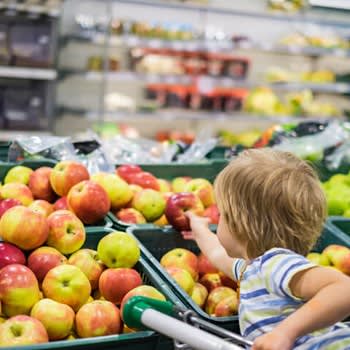Report: Over a Quarter of Households With an Infant Still Have Difficulties Getting Formula
Our analysis of December data from the U.S. Census Bureau shows just how dire the infant formula shortage continues to be in each state and in some of America's biggest cities.

- 27% of U.S. households with an infant under the age of one had difficulty obtaining baby formula in December 2022.
- In Mississippi, 68% of households had difficulty obtaining formula. This is the highest rate of any state in the U.S.
- More than 50% of households in Kansas, West Virginia, Nebraska, and Arizona had difficulty finding baby formula.
- In 18 states, at least one out of every three households struggled to obtain formula in December.
Amid a supply chain shortage that impacted everything from hot sauce and bicycles to chlorine, there is one item affected by the supply chain that millions of parents and their young babies can’t do without.
Baby formula shortages have created dire situations for many families, and in fact, our analysis of December data from the U.S. Census Bureau Household Pulse Survey finds more than a quarter of households with an infant under the age of one reported difficulty obtaining baby formula in December.
In some states, more than half of households with an infant under the age of one reported difficulty finding formula.
The chart below shows the percentage of households with an infant under the age of one that reported difficulty obtaining baby formula in December of 2022.
Click on image to enlarge in a new tab
In addition to having trouble finding formula, a significant number of households reported having no more than a one week’s supply of formula on hand. Nationwide, 64.5% of households with an infant under the age of one had a one-week supply or less of formula on hand.
In Wyoming, 92.5% of households had no more than a week’s supply of formula on hand. Other states with high rates include:
- North Carolina (89.5%)
- Montana (85%)
- Missouri (84.1%)
- Alaska (83.9%)
- Georgia (83.1%)
- Michigan (80.9%)
- New Hampshire (80.1%)
The baby formula shortage can vary within states and regions similarly to how it varies nationally. For instance, 59.5% of households in Riverside, CA, had trouble finding formula during the study period compared to just 30.4% of households in nearby Los Angeles. Statewide, 36.3% of California households had difficulty obtaining formula.
While only 27% of households in Phoenix reported difficulty finding formula in December, the statewide rate for Arizonians was 51.2%.
The chart below shows the percentage of households who reported difficulty obtaining formula in December for select cities throughout the U.S.
Click on image to enlarge in a new tab
The baby formula shortage can be attributed at least in part to several intersecting factors.
- Breastfeeding rates fell during the pandemic, as many new mothers were unable to get the assistance needed to breastfeed successfully due to Covid-19 restrictions, opening the door for an increased demand for formula. This was exacerbated by families who stockpiled formula and other supplies during the pandemic’s early panic buying, which similarly impacted supplies of toilet paper and other household items.
- Increased birth rates during the pandemic led to the “first major reversal in declining U.S. fertility rates since 2007.”
- In February of 2022, the Abbott Nutrition manufacturing plant in Michigan was shut down by the FDA after reports of bacterial infections surfaced. The plant was responsible for the production of more than 40% of the baby formula market share in the U.S. and was one of just three companies who produce nearly all the baby formula in the U.S. When the plant ceased operations, it left a sizeable hole in the supply chain in its wake.
- While the U.S. produces nearly all its own formula, some of the ingredients needed to do so are imported from other countries and were subject to the same pandemic-related supply chain problems experienced worldwide.
- High tariffs and trade restrictions make it difficult and expensive to import infant formula, discouraging foreign suppliers from entering the U.S. market and filling the gap. The U.S. produces approximately 98% of its own infant formula.
While the infant formula shortage is projected to last well into 2023, efforts to prevent future shortages and address the current challenges are underway.
- The U.S. has secured commitments to import millions of bottles of formula since May of 2022.
- The Abbott Nutrition plant reopened its doors in July and resumed production of its products.
- The Defense Production Act includes improved access to key materials for formula manufacturers.
- Operation Fly Formula was initiated to pick up overseas formula and transport it to the U.S., thereby speeding up importation and distribution.
Below are a few resources that may be of help to anyone having trouble obtaining baby formula or other necessary infant care supplies.
Free Formula Exchange
This free nationwide network connects families in need of baby formula with those who have extra formula to donate.
United Way’s 2-1-1
Those in need of formula may dial 2-1-1 to connect with a community resource specialist from United Way who may be able to assist with locating food pantries and other charitable resources that supply infant formula and baby food.
Feeding America
The network of Feeding America food banks sometimes stock infant formula or baby food. Use Feeding America’s local food bank finder to locate one near you.
Human Milk Banking Association of North America (HMBANA)
Certain HMBANA milk banks distribute donated breast milk to mothers in need. Find a milk bank near you and contact them about donated breast milk.
Community Action Agencies
A Community Action Agency may be able to supply you with formula or connect you with local agencies that have formula in stock. Search online to find a location near you.
The data used for this report came from the U.S. Census Bureau Household Pulse Survey, specifically Week 52 (Dec. 9 - Dec. 19, 2022, released January 5, 2023), the most recent data available.




